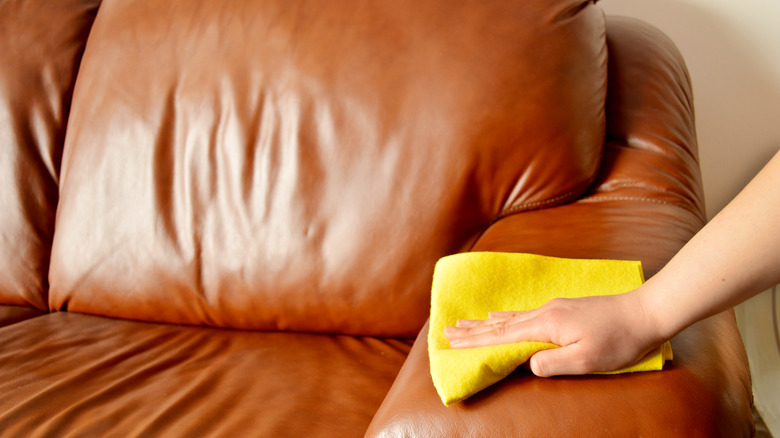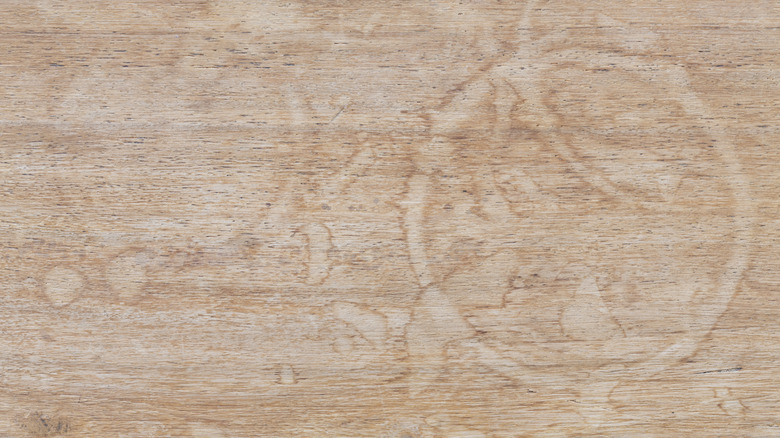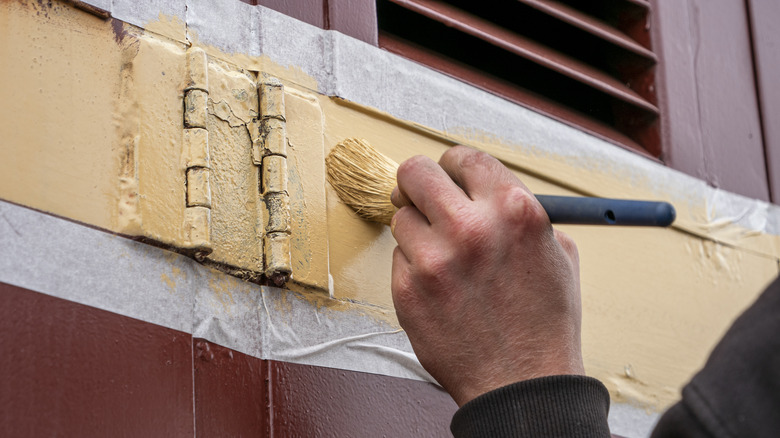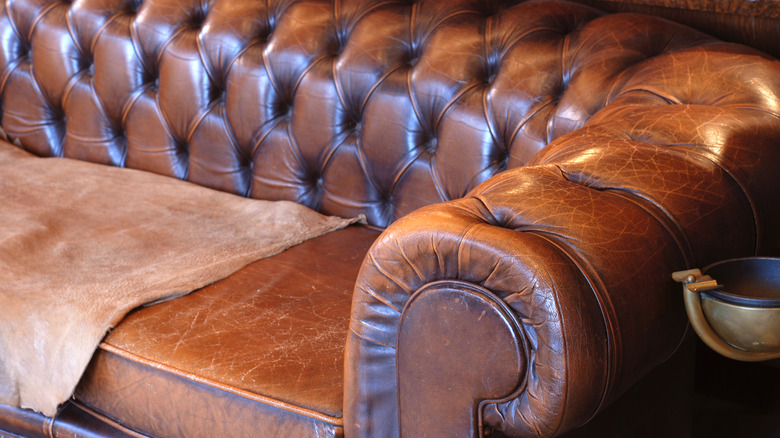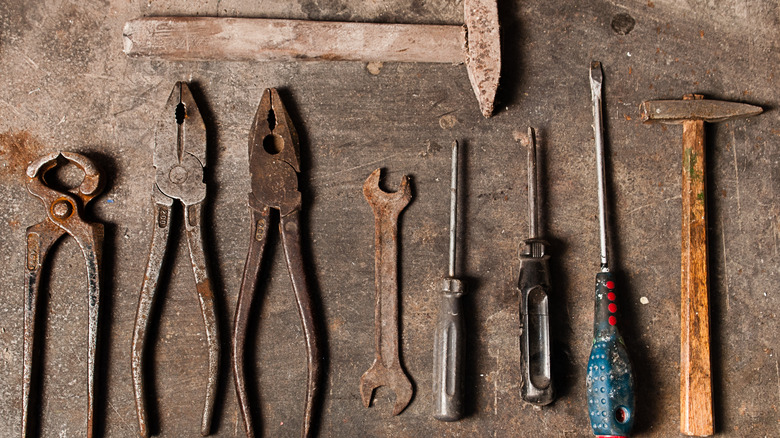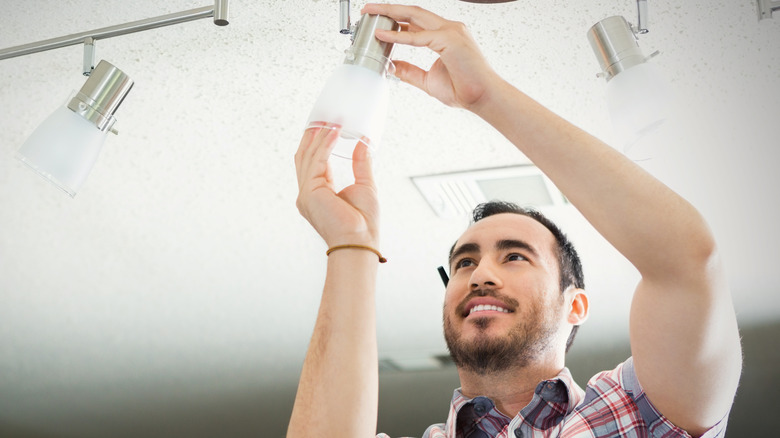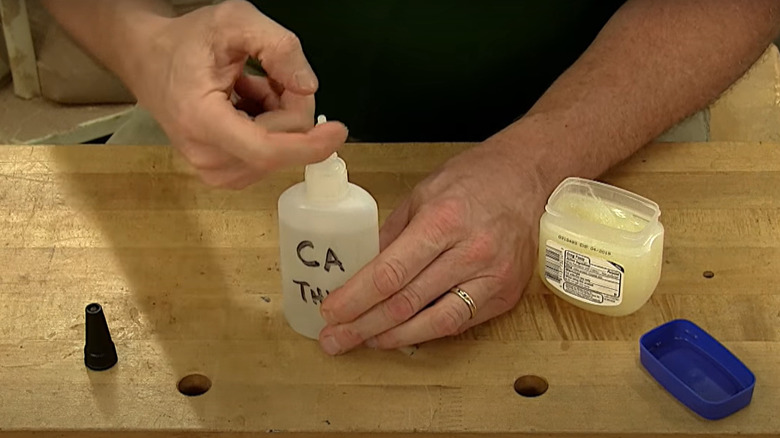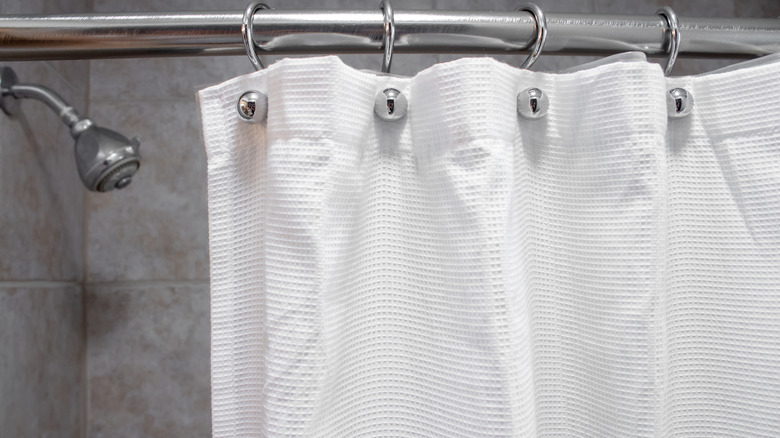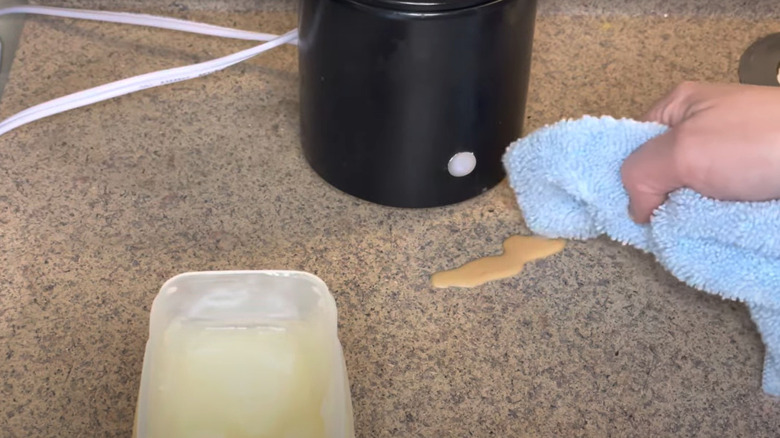Handy Ways To Use Vaseline Around The House
In the 150-odd years since its conception in 1870, Vaseline has become the gold standard for and is often used synonymously with petroleum jelly. Consisting of white petrolatum, this product boasts 100% petroleum jelly that's purified three times during manufacturing to remove all traces of contaminants. Since this gelatinous substance is considered non-toxic and enjoys a low-hazard score of 1 on EWG's Skin Deep verification scale, this tub of goodness has been primarily associated with skincare. However, that's not all it's good for.
Vaseline has multiple other uses around the house. For instance, Vaseline claims it can work wonders on stiff locks during winter and get them working in a jiffy, restore your mirror's former glory, and remove unsightly makeup stains from your linens and garments. While a commendable feat, these uses don't even scratch the surface of what this clear jelly can do. So, dig out your tub from the medicine cabinet, grab a few microfiber cloths, and get ready to discover the handy ways to use Vaseline around the house.
Remove water stains from wooden furniture
Wooden furniture has been popular among homeowners since time immemorial due to its elegant look and durability. However, placing hot or cold objects on a wooden surface without a coaster can give way to unsightly watermarks over time. This is because the moisture from these items breaches the surface of the wood and leaves cylindrical white marks in its wake. If left untreated, the moisture can cause irreversible harm to your furniture. Thankfully, this Vaseline hack will make removing water stains a breeze. Wipe the stain to ascertain it's completely dry before applying a generous amount of jelly on the stained areas and working it into the wood.
You can either use your fingers or enlist a microfiber cloth if you don't want to get your hands greasy. Now, let the clear jelly work its way into the wooden surface for 24 hours (or overnight). After the time is up, use another cloth to buff the stained spots and polish them. The marks will be gone since the greasy petroleum jelly will replace the moisture. If the stain is incredibly stubborn, apply a fresh coat and let the gelatinous substance work its magic one more time. While there's no scientific study backing this hack, Vaseline and home cleaning companies recommend this approach. But keep in mind that this hack will work on light water stains only. If the stain has permeated past the wooden furniture's finish, you'll have to refinish it.
Protect your hardware while painting
While painting items around the house, it's common for accidental splashes to land on hardware like doorknobs, hinges, lock mechanisms, cabinet handles, and hooks. To combat this, you either have to remove and cover all hardware beforehand or spend precious time scrubbing them clean afterward to keep them from getting stuck. However, professional painters and artists suggest using Vaseline to cut down the prep time when taking on a painting project. Begin by wiping and scrubbing the hardware clean to ensure the petroleum jelly sticks to the surface and doesn't come off midway through your project.
Use your fingers or a thin paintbrush to spread a thin layer of the translucent jelly on the hardware. Do this carefully, taking care not to smear areas you'd like painted. After the hardware is coated, go about your painting project as usual since Vaseline will hold the front line and effectively create a barrier between the paint and the surface. This will keep the splatters from sticking to the hardware and make your life easy. Once you're done, step back and let the paint dry completely before using a paper towel or microfiber cloth to wipe the coated hardware clean.
Restore your scuffed wooden furniture's former glory
If your home features luxurious and timeless wooden furniture, you might be all too familiar with the scratches and nicks this surface can develop over time. Though they won't impede the furnishing's functionality, they'll mar their beauty. But don't despair. You can bring your scuffed up wood cabinets back to life with a simple Vaseline hack shared by trusted wooden furniture brands. All you have to do is take a little bit of the petroleum jelly, rub it into the nicks, and leave the surface undisturbed for 24 hours.
Then, use a clean microfiber cloth to wipe away the remnants and buff the surface. Be gentle and try to rub a little jelly into the dents and nicks to cover the imperfections thoroughly. This hack works because Vaseline causes the wood surrounding the dents to expand and conceal them, not because this gelatinous substance makes the dents magically disappear. Remember, while this approach will work on minor scuffs and scratches on a wooden surface, it won't be of much use if you want it to hide significant imperfections.
Fix light scratches in your leather furniture
Leather is a popular furniture fabric produced from tanned animal skin. Such durable and long-lasting furnishings are sealed post-production to keep them looking new for years to come. However, exposure to sunlight, moisture, and sharp items leads to the development of scratches. So, if you're facing this issue, just imitate renowned leather companies and use Vaseline to fix up your scuffed leather furniture in a jiffy. But first, use a damp microfiber cloth to clean the furniture's surface and remove all dirt and dust. After you're done, scoop up a little translucent jelly using a paper towel or clean microfiber cloth and apply it in a circular motion on the scratched sections.
Let Vaseline stay for five minutes to give it ample time to fill in the gaps and cover the scuff marks. Once the time is up, take another clean cloth and use it to clean the residual jelly. Remember to conduct a spot test on an inconspicuous area to see if your furniture reacts adversely to the petroleum jelly. Also, keep in mind that this is a temporary solution at best and would only work on surface-level scratches. If the scratches are too deep, you'll have to turn to a leather conditioner or leather fiber binder.
Keep your metal hardware and tools free from rust
Metal hardware and tools, like hammers, nuts, and bolts, are indispensable and have multiple uses around the house. Unfortunately, they're susceptible to developing a layer of rust when they come in contact with moisture. Luckily, you can put such minor inconveniences behind you with this petroleum jelly hack that helps prevent rust. Rub your hardware and tools dry, and then cover them with the jelly. That's it; that's all you have to do before storing them.
Research by Andre Green from DePaul University shows that this hack works since Vaseline contains mineral oil and forms an effective barrier between your metal tools and the environmental compounds. He pitted this product against other household items that allegedly prevent rust, namely liquid dish soap and paint. He took three nails, coated each one in one of the products, and placed them in a half-full cup of water. After observing the three items over a period of six weeks, he concluded that the metal nail coated with Vaseline held out the longest, followed by paint and dish soap. Though this hack will work brilliantly on tools with rubber or wooden handles, be cautious when you slather this greasy product on an all-metal tool to avoid turning them slippery.
Prevent light bulbs from sticking to the socket
Replacing old light bulbs with a new one should ideally take you no more than a few minutes. But, in reality, rusted sockets or stuck bulbs make the task more challenging than it has to be. What's worse is if the glass portion breaks and leaves you with the dreaded task of removing the metal cap with jagged edges without cutting yourself. If you've ever been in this predicament, it's time to prevent your light bulbs from sticking in the light socket with this clever Vaseline hack.
So, the next time you put in a lightbulb, get an alcohol-dampened cotton pad and rub it across the threads of the bulb to clean them. Give it some time to air dry before dipping a finger in the tub of petroleum jelly and smoothening a thin layer onto the threads. Don't go overboard, and be sure to wipe off any excess with a paper towel or microfiber cloth to avoid unwarranted fire hazards. Screw the bulb into the socket and bid your stuck-light-bulb woes goodbye. The added lubrication will keep the bulb from getting stuck to the socket and make future replacements less harrowing. Note that although this hack doesn't have scientific backing, Vaseline swears by it, and several people have also found anecdotal success.
Prevent dried glue from sealing the cap shut
Glues are a must-have in every home. After all, how else are you supposed to undertake craft projects, clumsily repair broken items before their absence is noticed, or indulge in (mostly) innocent pranks? But when you're using really sticky adhesives like Gorilla, Super, or Krazy Glue, you're bound to seal the cap back on without wiping the excess glue, effectively sealing the cap and the bottle together. This leaves you with no option but to tug at the cap with pliers or a knife, or eventually give up and throw the bottle away.
If you keep finding yourself in such situations, give your muscles some much-deserved rest and prevent your glue bottle from drying shut with Vaseline. This hack is championed by many DIYers. Clean the wet glue off the rim with a clean microfiber cloth and dab some petroleum jelly on it. You can even coat the underside of the cap if the glue is incredibly sticky. This gelatinous coating will keep the cyanoacrylate glue varieties from adhering to the cap's surface and sealing the cap shut. For best results, store the glue bottle in an airtight bag to prevent humidity from activating the adhesive.
Get your shower curtains to glide smoothly
Shower curtains are as much a style statement as they're functional—they help maintain privacy and prevent water from leaving the secluded bath area. So, it's annoying when they stop gliding smoothly and need to be tugged at repeatedly. But no more. Simply get the tub of Vaseline from your medicine cabinet and use it to fix a hard-to-open shower curtain, a tip many DIYers swear by. Begin by taking the curtain and the associated rings off the rod and giving the length of the pole a deep clean to get rid of the accumulated dirt, hair, dead skin cells, and dust.
Now, let the rod air dry or use a cloth to wipe away the excess water. Follow up by smearing a thin layer of Vaseline along the length of the rod. This will allow the lubricant to keep your curtain rings from getting stuck. Don't be overzealous, as you don't want the gelatinous jelly to stain your fancy curtain fabric. After you're done, hang the curtain back and enjoy a smooth glide every time you grab a shower. Remember, this isn't a permanent solution, and you'll have to keep reapplying the clear jelly whenever the curtain rings feel stuck.
Keep ants away from your pet's food bowl
If you notice a small army of ants marching in an orderly fashion toward your pet's food bowl, it's time to put a stop to their shenanigans. Take the advice of pet food brands and create a ring of Vaseline to keep ants from invading your pet's food bowl. Dip a finger in the petroleum jelly and apply a generous layer to the bottom of your pet's food bowl. Don't leave any gaps for the ants to capitalize on, rendering your hard work useless.
Since the jelly will create a slippery surface, the six-legged creatures won't be able to get past it. This non-toxic and inexpensive solution will keep the marching armies away from your furry friend's food. However, this hack comes with its fair share of downsides. First of all, if your pets, like dogs or cats, consume all the smeared Vaseline, it might upset their digestive system. Secondly, this hack works on the assumption that your pet is fluent in dinner etiquette and won't leave behind crumbs for the ants to attack. Thirdly, the sticky bowl will attract dust and debris, necessitating regular cleanup. You'll also have to reapply the Vaseline from time to time to maintain the status quo.
Remove dripped candle wax
Lighting candles in your home is a good practice to build a tranquil and warm atmosphere. However, the dripped candle wax can often ensure the enjoyment is short-lived since you've to begin scraping it off of your table or shelf. But what if we told you that you could light all the candles you want without worrying about the cleanup? Several DIY enthusiasts emphasize that Vaseline is one of the simplest and best ways to get candle wax off a surface.
Before you begin, ensure the wax has cooled off completely to avoid spreading the gooey mess. Put a little petroleum jelly on your finger (microfiber cloth and paper towel work, too) and apply it in and around the spilled wax. Now, let it sit undisturbed for 10 to 15 minutes. After the time is up, use a damp cloth (or a plastic scraper) to work your way around the edges and remove the wax in sizable sections without scratching the surface underneath. This hack works on all types of surfaces, from countertops to tiles (with grout!) and hardwood floors.
